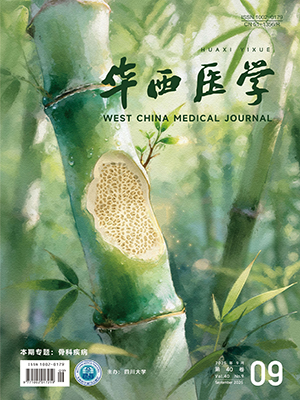【摘要】 目的 探讨伽玛刀治疗垂体腺瘤远期肿瘤控制及并发症发生情况。 方法 2004年6月-2006年12月共158例垂体腺瘤患者接受伽玛刀治疗。伽玛刀治疗边缘剂量12~30 Gy,以45%~70%等剂量曲线覆盖肿瘤灶。术后定期对患者进行门诊随访和鞍区增强MRI扫描,记录肿瘤控制及并发症发生情况。 结果 131例患者完成随访,平均随访时间49个月。至随访结束,共7例患者肿瘤增大复发。伽玛刀治疗后1、2、3、4及5年肿瘤控制率分别为95.8%、95.8%、95.8%、95.8%及93.9%。46例患者(35.1%)在治疗后出现暂时性头痛和感觉异常,对症处理后缓解;4例患者(3.1%)出现垂体功能低下,接受激素替代治疗。未观察到其他颅神经和血管损害表现。 结论 伽玛刀治疗垂体瘤远期疗效肯定,并发症轻微,是一种安全可靠的垂体瘤治疗手段。
【Abstract】 Objective To explore the long-term tumor control and side effects of gamma knife treatment for pituitary adenoma. Methods One hundred and fifty-eight patients with pituitary adenoma undergone gamma knife treatment were periodically followed up from June 2004 to December 2006. The prescript radiation dosage was 12-30 Gy. An enhanced MRI scan was scheduled every 6-12 months after the treatment. The tumor sizes of different scan were compared and the side effects were recorded. Results One hundred and thirty-one patients finished the follow-up procedure with an average time of 49 months. One hundred and twenty-four patients received good tumor control at the end of the research and recurrence was seen in seven patients. The 1-, 2-, 3-, 4-, and 5- year tumor control rates were 95.8%, 95.8%, 95.8%, 95.8%, and 93.9% respectively. Forty-six patients showed temporal and were relieved after treatment. Hypopituitarism was seen in four patients but no cranial nerve or vascular damage was detected. Conclusion The long-term effect of gamma knife therapy for pituitary adenoma remains good and the incidence of side effects is low. Gamma knife therapy could be a safe and effective choice for pituitary adenoma treatment.
Citation: LI Peng,WANG Wei,YANG Wei,MAO Boyong,WANG Xing,ZHONG Qi,REN Haibo. The Long-Term Result of Gamma Knife Treatment for Pituitary Adenoma. West China Medical Journal, 2010, 25(9): 1638-1640. doi: Copy
Copyright © the editorial department of West China Medical Journal of West China Medical Publisher. All rights reserved




